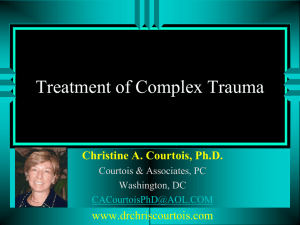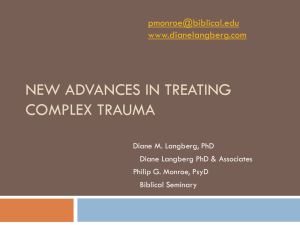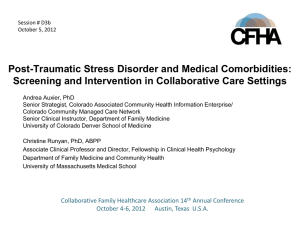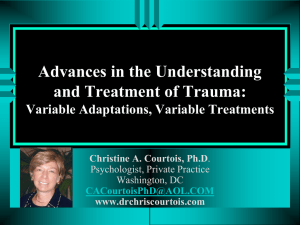FINAL-CHRISTINE-COURTOIS-WEBINAR
advertisement
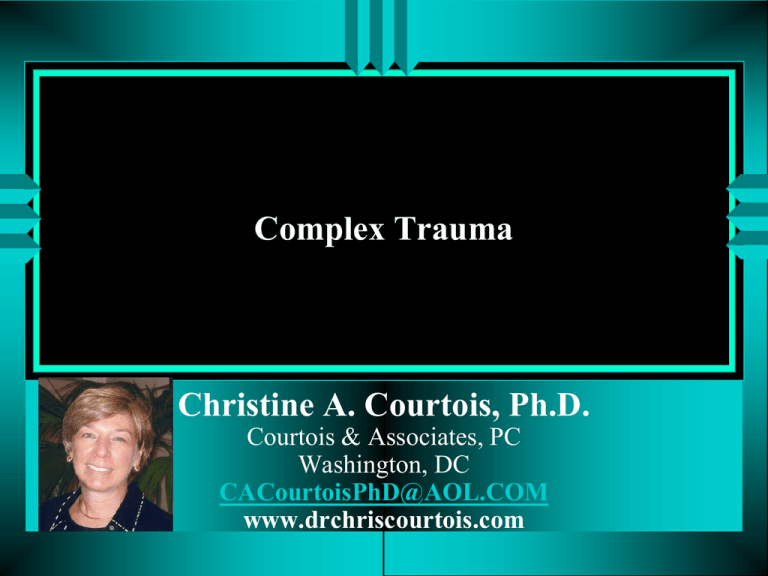
Complex Trauma Christine A. Courtois, Ph.D. Courtois & Associates, PC Washington, DC CACourtoisPhD@AOL.COM www.drchriscourtois.com Lisa Firestone, Ph.D. The Glendon Association PsychAlive.org Check in through PsychAlive’s social media: Follow us on Twitter http://twitter.com/@psychalive Get the latest news on PsychAlive Webinars and Events Tweet this webinar:#psychalivewebinar Like us on Facebook http://www.facebook.com/PsychAlive Types of Trauma • • • • • Type I: Impersonal Type II: Interpersonal Type III: Lifelong Type IV: Identity Type V: Community Poll #1 Do you work with people who have experienced trauma? • • Yes No Interpersonal Trauma “ “A break in the human lifeline” Robert J. Lifton Types of Interpersonal Trauma • • • • • • • Attachment/relational Physical and sexual abuse Emotional/verbal/bullying/antipathy Neglect/non-response or protection Layered Betrayal Secondary/ “second injury”/institutional What is Complex Trauma? Some Characteristics • • • • Interpersonal Abuse of all types and neglect/non-response Repetitive, prolonged, chronic, cumulative Often in attachment relationships Dependence/immaturity, accessibility and entrapment • Often over the course of childhood Layered, cumulative Impacts development • May be lifelong: same or different perpetrators Trauma and Development • • Attachment/relational trauma Attachment style and Inner Working Model Secure Insecure Disorganized • • Lack of self validation/reflection Effect on brain development Survival brain vs. learning brain Attachment Trauma and Development • Can effect development starting at the neuronal level Neurons that fire together wire together • • • Can affect brain structure and function Right brain/sensory-motor imprint Left brain development impeded There may be no words Speechless terror Poll #2 Do you have clients that meet this criteria for complex trauma? • • Yes No Limbic System of the Brain Limbic System of the Brain Posttrauma Adaptations (adapted from Wilson, 1989) Note: most adults, even when seriously traumatized have posttraumatic reactions; and do not develop PTSD (18-25% do). However, complex trauma, especially over the course of childhood most often leads to PTSD (75% + do). DSM-IV Criteria: PTSD • • • • A. Exposure or experience B. Persistent reexperiencing, intrusions, dreams of trauma, distress at re-exposure C. Persistent avoidance of stimuli associated with the trauma and numbing D. Persistent symptoms of increased arousal DSM-5 New Criteria • • • • • Now a category of trauma disorders Drop/expand Criterion A Separate criteria of Numbing from Avoidance To Criterion B, add emotional dysregulation and additional emotions A subtype of Dissociative PTSD will be added Post-trauma Responses and Disorders Complex Posttraumatic Stress Disorder/ • related to severe chronic abuse, usually in childhood, and attachment disturbance • usually highly co-morbid • involves a high degree of dissociation Dissociative Disorders • associated with disorganized attachment and/or abuse in childhood • can develop in the aftermath of trauma that occurs any time in the lifespan (DESNOS) “PTSD plus or minus” Complex Posttraumatic Stress Disorder Disorders of Extreme Stress Not Otherwise Specified (DESNOS) • • Accounts for developmental issues, comorbidity/co-occurrence, memory variability and to reduce stigma Co-morbidity: • distinct from or co-morbid with PTSD • other Axis I, mainly: depressive, dissociative, and anxiety disorders substance abuse/other addictions impulse control/compulsive disorders • Axes II and III: multiple conditions Symptom Categories and Diagnostic Criteria for Complex PTSD/DESNOS l. Alterations in regulation of affect and impulses • • • • • • a. Affect regulation b. Modulation of anger c. Self-destructiveness d. Suicidal preoccupation e. Difficulty modulating sexual involvement f. Excessive risk taking 2. Alterations in attention or consciousness • a. Amnesia • b. Transient dissociative episodes and depersonalization Symptom Categories and Diagnostic Criteria for Complex PTSD/DESNOS 3. Alterations in self-perception • a. Ineffectiveness • • • • • b. Permanent damage c. Guilt and responsibility d. Shame e. Nobody can understand f. Minimizing 4. Alterations in perception of the perpetrator • a. Adopting distorted beliefs • b. Idealization of the perpetrator • c. Preoccupation with hurting the perpetrator Symptom Categories and Diagnostic Criteria for Complex PTSD/DESNOS 5. Alterations in relations with others • a. Inability to trust • b. Revictimization • c. Victimizing others 6. Somatization • a. Digestive system • • • • b. Chronic pain c. Cardiopulmonary symptoms d. Conversion symptoms e. Sexual symptoms 7. Alterations in systems of meaning • a. Despair and hopelessness • b. Loss of previously sustaining beliefs Evidence-Based Practice • • • Best research evidence Clinical expertise Patient values, identity, context American Psychological Association Council of Representatives Statement, August 2005 Effective Treatments for PTSD* • • • • • • Psychopharmacology Psychotherapy, group and individual CBT, (PE and CPT, especially) EMDR Psych-education Other supportive interventions *Few studies have evaluated using a combination of these approaches although combination treatment commonly used and may have advantages Poll #3 Which of these treatments, if any, do you use with your patients? Psychopharmacology Psychotherapy, group and individual • CBT • EMDR • None of the Above • • Complex Trauma Treatment • Problems with affect regulation may rely on maladaptive behaviors, substances problems with safety • Problems with disorders of the self, attachment relationships negative self-concept re-victimization/re-enactments needy but mistrustful • • • Problems functioning? Physical/medical concerns Other... Recommended Treatments for Complex PTSD • • • Sequenced or phase based Interventions tailored to specific symptoms “First line” Emotional regulation Narration of trauma memory Cognitive re-structuring Anxiety and stress management Interpersonal Recommended Treatments for Complex PTSD “Second line” • Meditation/mindfulness Course and duration of treatment unclear “Hybrid” Models for Complex Trauma • • • • • • • TARGET (Ford) STAIR-NTP (Cloitre) Seeking Safety (Najavits) ATRIUM (Miller) SAFE Alternatives (Conterio & Lader) DBT (adapted) Other models and workbooks... Treatment Goals for PTSD • • • • • • • Educate about and de-stigmatize PTSD sx Increase capacity to manage emotions Reduce co-morbid problems Reduce levels of hyper-arousal Re-establish normal stress response Decrease numbing/avoidance strategies Face rather than avoid trauma, process emotions, integrate traumatic memories Treatment Goals for PTSD • Restore self-esteem, personal integrity normal psychosexual development reintegration of the personality • Restore psychosocial relations trust of others foster attachment to and connection with others • • • Restore physical self Restore spiritual self Prevent re-victimization/re-enactments SAFETY IS THE FOUNDATION Treatment Goals for Complex Trauma • • • • All the same but more Developmental implications PTSD symptoms Co-occurring problems Depression, anxiety, substance abuse, dissociation, OCD, phobias, medical and somatic conditions, functioning Treatment Principles for All Types of Trauma “First, do no more harm” Treatment can help and treatment can hurt both the helper and the client Treatment Principles • • • • Treatment meets standard of care Treatment is individualized Client empowerment/colloboration Safety and protection safety of self and others, to and from others • Relationship issues, caring, acceptance, and empathy • Informed consent/refusal; client rights Treatment for Complex Trauma • Sequenced treatment • Specialized techniques, applied later – EMDR for resource installation/affect mgt, CBT (exposure therapies), CPT, stress inoculation • Other techniques as needed (careful application) – relaxation, exercise, group, education, wellness • Group, couple or family work Complex Trauma Treatment • • • • • “Not trauma alone” (Gold, 2000) Multi-theoretical and multi-systemic Integrative Addresses attachment/relationship issues in addition to life issues and trauma symptoms and processing of traumatic material Sequenced Poll #4 Have you heard of Treatment Sequence for complex trauma? Yes • No • Treatment Sequence • • • Safety, stabilization, skill-building, treatment alliance Trauma processing Integration and meaning, self and relational development Treatment Like Posttraumatic Disorders, comprehensive treatment must be BIOPSYCHOSOCIAL/SPIRITUAL & Culture and Gender Sensitive Bio/Physiological Treatments • Psychopharmacology – evidence base developing re: effectiveness – algorithms developed – not enough by itself • Medical attention – preventive – treatment • Movement therapy Bio/Physiological Treatments • • Stress management Self-care/wellness: Exercise (w/ care) Nutrition Sleep Hypnosis/meditation/mindfulness Addiction treatment – Alcohol, drugs, prescription drugs – Smoking cessation – Other addictions (sexual, spending) – Relapse planning Bio-physiological Treatments • Somatosensory/body-focused techniques (Levine; Ogden; Rothschild, Scaer) • • • • • Remember: The brain is part of the body! Paying attention to the body in the room interpersonal neurobiology Neurofeedback/EEG Spectrum Massage and movement therapy Dance and theatre Yoga Psychosocial/Spiritual Treatments • • • The therapy relationship--has the most empirical support of any “technique” Especially important with the traumatized Especially important in interpersonal violence and in developmental trauma attachment studies brain development studies striving for secure attachment Psychosocial/Relational and Spiritual Treatments Psych-education (individual or in group) Individual and group therapy • • • • trauma focus vs. present focus skill-building core affect and cognitive processing developing connection with others – identification and meaning-making • concurrent addiction/ED Couple and family therapy Psychosocial/Spiritual Treatments • Adjunctive groups/services • AA, Al-Anon, ACA, ACOA, etc. social services/rehabilitation career services internet support and information Spiritual resources: finding meaning in suffering pastoral and spiritual care organized religion other religion/spirituality nature, animals Cognitive Behavioral, Emotional/ Information Processing Treatments • Education & skill development numerous workbooks now available on a wide variety of topics - general, CD, self-harm, risk-taking, eating, dissociation, spirituality, career, etc. • Exposure and desensitization (Foa et al.) • prolonged & graduated Writing/journaling CPT (Resick) Journaling (Pennebaker) Cognitive Behavioral, Emotional/ Information Processing Treatments • • Schema therapy (Young; McCann & Pearlman) Dialectic Behavior Therapy (DBT)--may involve “tough love stance” (Linehan) mindfulness and skill-building • • Narrative therapies (various authors) Strength/resilience development Affect-Based Treatments • AEDP: Accelerated Experiential-Dynamic Psychotherapy (Fosha) • Repair of the Self • Techniques for identifying and treating dissociation (ISSD, Kluft, Putnam, Ross, others) • Relational and affect-based psychoanalytic techniques (Bromberg, Davies & Frawley, Chefetz, others) (Schore, others) Relational/Attachment Treatments • Understand client’s attachment style and Inner Working Model Helps expect how the client relates and behaves • • Strategize how to respond Goal: to move to secure attachment through insights gained in and through the therapy relationship Relational/Attachment Techniques • Interpersonal neurobiology (Schore, Siegel) • Relational & affect-based Patient in relationship with others • • determine attachment style Therapist determine attachment style - secure connection with the therapist to foster secure connections elsewhere (“earned security”) - transference/countertransference, enactments, VT • Spouse/partner/significant other couple and family work Relational/Attachment Techniques • Internalization of attachment • Children • parenting help/training • Friends • • substitute family social and friendship skills • Support systems Hypnosis/Guided Imagery Techniques Caution: for ego development, self-soothing, attachment, not for memory retrieval Expressive Techniques • Art • • • collage images pottery/clay work Poetry/writing Psychodrama Movement Spirituality/Mindfulness • • • • • • • • Nature Specific spiritual writers and orientations The meaning of suffering Existential issues Religion Pastoral care/spiritual issues Prayer Spiritual formation Cultural/Ethnic/Gender/Religious • Social context/ethnic group and how it might contributes to trauma racism, sexism, heterosexism and homophobia, cultural or ethnic norms, colonialism, etc. • • • Blocks or supports to healing Take these issues into account Healing rituals/healers Expert Consensus Guidelines for “Classic PTSD” ISTSS Guidelines (Foa, Friedman, & Keane, 2000, 2008) Journal of Clinical Psychiatry (2000) American Psychiatric Association (2003) Clinical Efficiency Support Team (CREST, Northern Ireland, 2003) Veterans’ Administration/DoD (US, 2004) National Institute of Clinical Excellence (NICE, UK, 2005) Australian Centre for Posttraumatic Mental Health (2007) Expert Consensus Guidelines for Complex PTSD Under development and anticipated this year • ISTSS (Cloitre & Courtois, co-chairs) • ISST-D/Division 56 (Courtois, chair) Available • ISTSS complex trauma expert consensus survey, Cloitre, Courtois, et al., 2011 • Courtois, Ford & Cloitre, 2009 • CREST, 2003 • Courtois, 1999 Other Expert Consensus Guidelines Dissociative Disorders • Adult (ISSD, 1994, 1997, 2005, 2011) • Children (ISSD, 2001) Delayed memory issues • Courtois,1999; Mollon, 2004 Coming later this year • Courtois & Ford, The Treatment of Complex Trauma: A Sequenced, Relationship-based Approach (Guilford) • Ford & Courtois (Eds.). Treating Complex Traumatic Stress Disorders in Children and Adolescents: An Evidence-based Guide (Guilford) Resources • • • • • • ISTSS.org ISSTD.org--new name; formerly (ISSD.org) • 9 month-long courses on the treatment of DD’s-various locations NCPTSD.va.gov (info and links) NCTSN.org (child resources) Sidran.org (books and tapes) APA Division 56, Psychological Trauma traumadivision@apa.org please join!! Upcoming Webinars with Lisa Firestone, Ph.D. For Professionals: Suicide: What Every Mental Health Professional Needs to Know CE Webinar Sep. 25 - 4pm – 5:30pm PDT For the Public: How to Raise an Emotionally Healthy Child Free Webinar Dec. 4 - 12pm – 1pm PST Learn more or register at http://www.psychalive.org/2012/01/upcoming-webinars-2/ Upcoming Webinars with James Gilligan, M.D. Understanding & Effectively Treating Violence CE Webinar Oct. 16 - 4pm – 5:30pm PDT Why Does Violence Occur & How Can We Prevent It? Free Webinar Nov. 13 - 11am- 12pm PST Learn more or register at http://www.psychalive.org/2012/01/upcoming-webinars-2/ Lisa Firestone, Ph.D. Director of Research and Education – The Glendon Association Senior Editor – PsychAlive.org www.glendon.org www.psychalive.org CONTACT: Glendon@glendon.org To receive your CEs for this Webinar: * Upon completion of this Webinar, you will receive an email with an evaluation form and post-test for you to complete and return to the us within 10 days. You will also receive two articles by Dr. Courtois. These forms can be emailed, faxed or mailed back to us. Instructions will be given in the email you receive. Upon receiving your completed forms, a CE certificate will be mailed to you. * A recording of this Webinar will also be available online. Those unable to attend this live Webinar may view the recording, complete the evaluation form, and read the attached articles to receive 3 CE Credits for $35. A link to this recording will be sent to you as soon as you request it.



